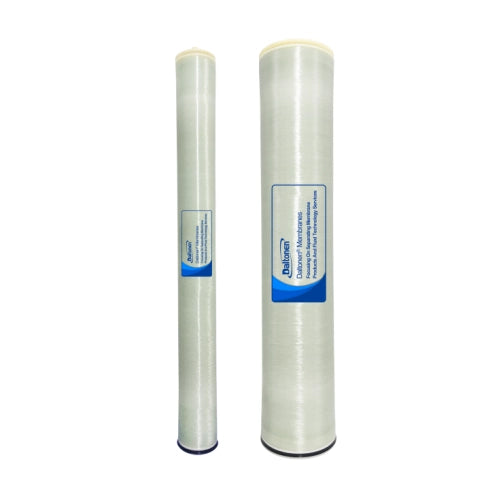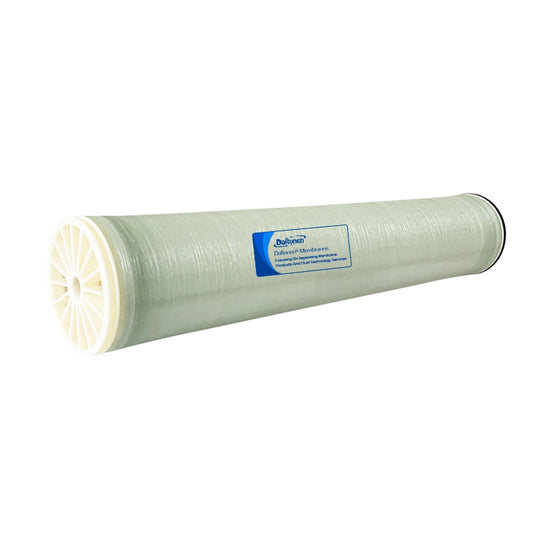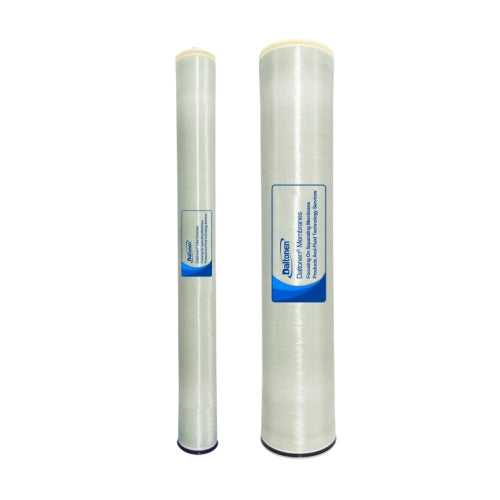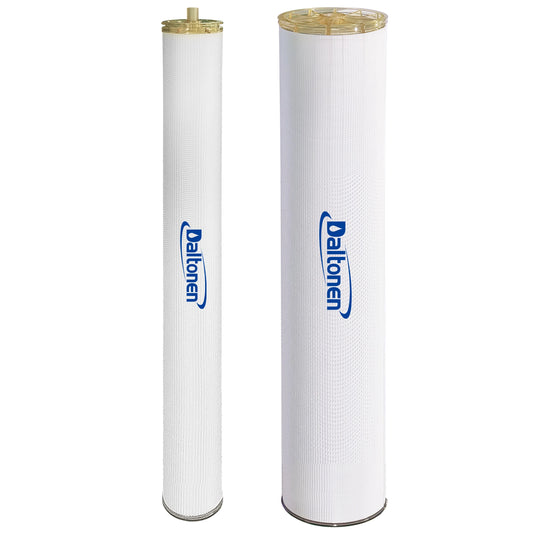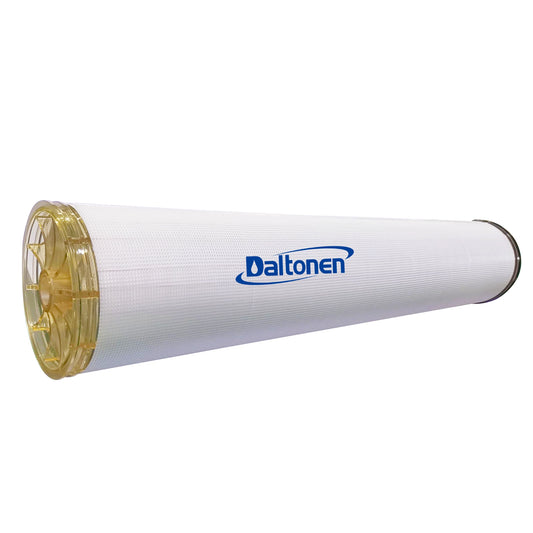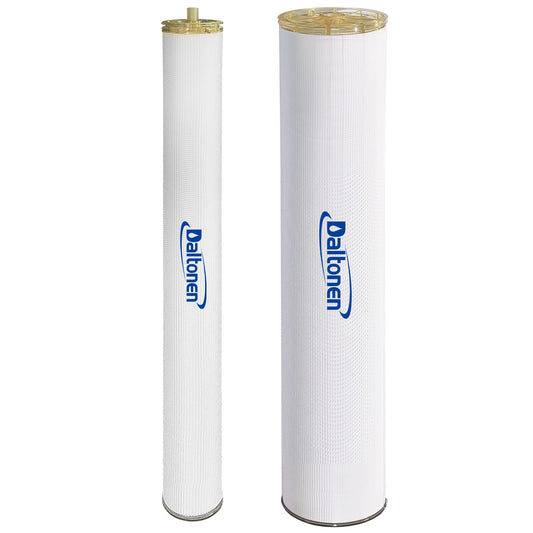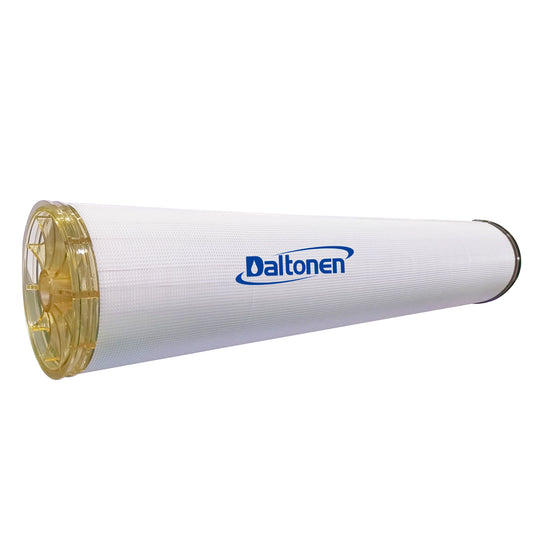How Can RO Membrane Technology Solve the Problem of Low-Salinity Dissolved Substances in Municipal Water?
30 Jun 2025
1. Principles of RO Membrane Technology
1.1 Basic Principle of Reverse Osmosis
Reverse osmosis is a physical process that uses pressure to diffuse water molecules from a high-concentration solution to a low-concentration solution. In municipal water treatment, the presence of low-salinity dissolved substances can affect water quality. RO membrane technology applies pressure higher than the osmotic pressure to force water molecules through a semipermeable membrane, while retaining the dissolved substances. Typically, the concentration of dissolved substances in municipal water fluctuates within a certain range, and RO membranes can effectively remove more than 90% of dissolved solids, significantly improving the quality of the treated water. For example, when the total dissolved solids (TDS) in the feed water is 500 mg/L, the TDS in the treated water can be reduced to below 50 mg/L after RO membrane treatment, meeting the water quality requirements for municipal use.
1.2 Structure and Materials of RO Membranes
RO membranes typically have a multilayer composite structure, which mainly includes a support layer, a transition layer, and a separation layer. The support layer primarily provides mechanical strength, with larger pores, generally ranging from tens of micrometers to hundreds of micrometers, capable of withstanding certain pressures to ensure the stability of the membrane. The transition layer connects the support layer and the separation layer, with gradually decreasing pore sizes, usually ranging from a few nanometers to tens of nanometers, allowing water to flow smoothly into the separation layer. The separation layer is the core part of the RO membrane, with extremely small pores, generally ranging from 0.1 nanometer to 1 nanometer, which can effectively retain dissolved substances. The materials of RO membranes mainly include cellulose acetate (CA) and aromatic polyamide (PA). Cellulose acetate membranes have good acid and alkali resistance and anti-pollution properties, but their desalination rate is relatively low, generally between 80% and 90%; aromatic polyamide membranes have high desalination rates (above 95%) and high water flux, but their anti-pollution and chemical resistance are relatively poor. In municipal water treatment, the appropriate RO membrane material is usually selected based on the water quality and treatment requirements.

2. Characteristics of Low-Salinity Dissolved Substances in Municipal Water
2.1 Main Components of Dissolved Substances
Low-salinity dissolved substances in municipal water mainly include a variety of inorganic salts and organic compounds. Common inorganic salts include chlorides, sulfates, and carbonates of calcium, magnesium, sodium, potassium, and other ions. Although the content of these inorganic salts in water is relatively low, they are diverse. For example, calcium and magnesium carbonates are the main components causing water hardness, with concentrations usually ranging from 10 mg/L to 50 mg/L. Organic compounds include humic acids, fulvic acids, proteins, polysaccharides, and so on, which mainly originate from the decomposition of animal and plant residues in natural water bodies and pollutants generated by human activities. Humic acids and fulvic acids are the main organic acid substances in water, with concentrations generally ranging from 2 mg/L to 10 mg/L. These organic compounds not only affect the taste and transparency of water but may also react with disinfectants to form harmful disinfection by-products.
2.2 Sources and Impacts of Dissolved Substances
Low-salinity dissolved substances in municipal water mainly come from natural water bodies, industrial wastewater, and domestic sewage. Dissolved substances in natural water bodies mainly originate from processes such as rock weathering, soil leaching, and atmospheric precipitation. For example, groundwater in limestone areas is rich in calcium and magnesium ions, with concentrations ranging from 20 mg/L to 80 mg/L. Dissolved substances in industrial wastewater and domestic sewage mainly come from chemical reactions in industrial production processes and the discharge of domestic water use. For example, wastewater discharged from dyeing factories contains a large amount of organic dyes and auxiliaries, with organic compound concentrations reaching above 100 mg/L; domestic sewage contains a large amount of proteins, fats, and carbohydrates, with concentrations generally ranging from 30 mg/L to 70 mg/L.
These dissolved substances mainly affect municipal water in the following ways:
-
Affecting water taste and transparency: The presence of low-salinity dissolved substances can cause water to have off-flavors and discoloration, reducing its taste and transparency. For example, humic acids and fulvic acids can give water a yellow or brown color, affecting its appearance.
-
Affecting disinfection effectiveness: Some dissolved substances can react with disinfectants, reducing their concentration and disinfection effectiveness. For example, organic compounds in water can react with chlorine to form chlorinated organic compounds, not only reducing chlorine's disinfection ability but also potentially generating harmful disinfection by-products such as chloroform.
-
Affecting the service life of pipes and equipment: Inorganic salt dissolved substances can deposit on the surfaces of pipes and equipment, forming scale, increasing pipe resistance, reducing equipment heat transfer efficiency, and shortening the service life of pipes and equipment. For example, the thickness of scale formed by calcium and magnesium ions deposited on the inner walls of pipes can reach 1 mm to 5 mm, reducing the inner diameter of the pipes and increasing water flow resistance.
-
Affecting the ecological environment: Discharging untreated municipal water containing low-salinity dissolved substances into the environment can have negative impacts on aquatic life and ecosystems. For example, excessive nitrogen and phosphorus nutrients can cause eutrophication of water bodies, leading to massive algal blooms and disrupting the ecological balance of water bodies.
3. Removal Mechanisms of Low-Salinity Dissolved Substances by RO Membranes
3.1 Physical Sieving Effect
The physical sieving effect is one of the key mechanisms by which RO membranes remove low-salinity dissolved substances. The separation layer of RO membranes has extremely small pores, typically ranging from 0.1 nanometer to 1 nanometer, which can effectively retain dissolved substances. In municipal water, inorganic salts such as chlorides, sulfates, and carbonates of calcium, magnesium, sodium, and potassium have hydrated diameters larger than the pore sizes of RO membranes, so they cannot pass through the membrane pores and are retained on the feed water side of the membrane. For example, the hydrated diameter of calcium ions is approximately 0.4 nanometers, and that of magnesium ions is about 0.3 nanometers. Under the physical sieving effect of RO membranes, the removal rate of these ions can reach over 90%. For organic compounds such as humic acids and fulvic acids, their molecular weights are large, and their molecular sizes are much larger than the pore sizes of RO membranes, so they also cannot pass through the membrane pores and are effectively retained. Studies have shown that RO membranes can achieve a removal rate of over 95% for organic compounds with molecular weights greater than 200 daltons, significantly improving the quality of municipal water.
3.2 Chemical Adsorption and Ion Exchange
In addition to the physical sieving effect, RO membranes also remove low-salinity dissolved substances through chemical adsorption and ion exchange mechanisms. The surface of RO membranes usually carries a charge, which can electrostatically adsorb ions in water. For example, the surface of aromatic polyamide membranes carries a negative charge, which can adsorb positively charged ions in water, such as calcium and magnesium ions. This electrostatic adsorption not only enhances the membrane's retention ability for ions but also reduces the deposition of ions on the membrane surface, lowering the risk of membrane fouling. Moreover, RO membranes can remove ions from water through ion exchange mechanisms. When ions in water exchange with fixed ions on the membrane surface, the ions in water are retained, and the fixed ions on the membrane surface enter the water. For example, calcium and magnesium ions in water can exchange with sodium ions on the membrane surface, thereby being removed. Studies have shown that through chemical adsorption and ion exchange mechanisms, the removal rate of calcium and magnesium ions in water by RO membranes can be further increased by 5% to 10%, resulting in more stable and superior treated water quality.
4. Process Optimization and System Design
4.1 Importance of Pretreatment
Pretreatment is crucial when RO membrane technology is used to treat municipal water. Municipal water often contains suspended solids, colloids, microorganisms, and other impurities, which can clog the pores of RO membranes, increase the risk of membrane fouling, and reduce the flux and service life of the membranes. For example, if the concentration of suspended solids in untreated municipal water reaches 10 mg/L, the flux of RO membranes can decrease by 30% in a short period. Pretreatment methods include coagulation and sedimentation, filtration, and disinfection. Coagulation and sedimentation can effectively remove suspended solids and colloids from water, reducing turbidity by over 90%; filtration further removes fine particles to ensure stable feed water quality; disinfection can kill microorganisms in water to prevent their growth on the membrane surface. Through pretreatment, the operating efficiency and stability of RO membranes can be significantly improved, their service life can be extended, and operating costs can be reduced.
4.2 Optimization of System Operating Parameters
The operating parameters of RO membrane systems have a significant impact on treatment effectiveness and economic viability. The main parameters include operating pressure, recovery rate, and temperature.
-
Operating Pressure: Operating pressure directly affects the permeation rate of water and the retention rate of dissolved substances. Typically, in municipal water treatment, the operating pressure of RO membranes ranges from 1.5 MPa to 3.0 MPa. As pressure increases, the permeation rate of water also increases. However, when the pressure exceeds a certain value, the compressive effect of the membrane reduces the increase in permeation rate. Studies have shown that when the operating pressure increases from 1.5 MPa to 2.5 MPa, the permeation rate of water can increase by 40%. However, when the pressure is further increased to 3.0 MPa, the permeation rate only increases by an additional 10%. Therefore, selecting an appropriate operating pressure is key to optimizing system operation.
-
Recovery Rate: The recovery rate refers to the ratio of the system's product water volume to the feed water volume. Increasing the recovery rate can reduce wastewater discharge, but an excessively high recovery rate can exacerbate concentration polarization on the membrane surface, increasing the risk of membrane fouling. In municipal water treatment, the recovery rate of RO membrane systems is generally controlled between 70% and 80%. For example, when the recovery rate is 70%, the concentration of dissolved substances on the membrane surface is only about three times that of the feed water concentration. However, when the recovery rate is increased to 85%, the concentration of dissolved substances on the membrane surface can reach more than six times that of the feed water concentration, significantly increasing the risk of membrane fouling.
-
Temperature: Temperature also has a significant impact on the permeation performance of RO membranes. As temperature increases, the viscosity of water decreases and the diffusion coefficient increases, which is beneficial for water molecules to pass through the membrane pores. However, it can also reduce the retention rate of dissolved substances by the membrane. The temperature of municipal water generally ranges from 5°C to 30°C. Studies have shown that within the temperature range of 15°C to 25°C, the permeation rate of water increases linearly with temperature, with an increase of 3% to 5% for every 1°C rise in temperature. Therefore, when designing RO membrane systems, the temperature variations of municipal water should be considered, and operating parameters should be adjusted reasonably to ensure stable system operation and efficient treatment.

5. Case Study Analysis of Engineering Applications
5.1 Successful Case Sharing
In the field of municipal water treatment, RO membrane technology has been successfully applied in the water supply systems of several cities, significantly improving water quality and solving the problem of low-salinity dissolved substances. For example, in a municipal water supply project in a coastal city, the city's raw water was affected by seawater intrusion, containing higher concentrations of low-salinity dissolved substances such as chlorides and sulfates, with feed water TDS values ranging from 350 mg/L to 450 mg/L. After adopting RO membrane technology, the TDS value of the treated water remained stable below 30 mg/L, meeting the national drinking water standards and satisfying the residents' water needs. This project has been stably operating for over five years, with an average service life of RO membranes reaching three years. The membranes were replaced only once during this period, demonstrating good economic viability and reliability. Additionally, in a municipal water supply system in an inland city, the raw water mainly came from surface water, containing a large amount of organic compounds and hardness components. The application of RO membrane technology reduced the organic compound content in the treated water to below 1 mg/L, with a hardness removal rate of over 95%, effectively solving the problems of water taste and disinfection by-products and improving the quality of life for residents.
5.2 Problems Encountered and Solutions
Despite the significant achievements of RO membrane technology in municipal water treatment, some problems have also been encountered in practical applications. One of the most common problems is membrane fouling. Membrane fouling can lead to a decrease in membrane flux, increasing operating costs and energy consumption. For example, in the coastal city water supply project mentioned above, initially, due to an imperfectly designed pretreatment system, a large amount of microorganisms and organic compounds were deposited on the surface of the RO membranes, causing the membrane flux to decrease by 40% after only three months of operation. To address this issue, the following measures were taken: First, the pretreatment process was optimized by adding ozone oxidation and activated carbon adsorption units, effectively removing organic compounds and microorganisms from the water and reducing the risk of membrane fouling. Second, regular chemical cleaning was carried out, selecting appropriate cleaning agents based on the type of membrane fouling. For example, acidic cleaning agents were used to remove inorganic scale, while alkaline cleaning agents were used to remove organic compound contamination. Through these measures, the membrane flux was restored to more than 80% of its initial value, extending the service life of the membranes. Another problem is the high energy consumption during system operation. In municipal water treatment, RO membrane systems typically require higher operating pressures to drive water molecules through the membrane pores, resulting in significant energy consumption. To reduce energy consumption, energy recovery devices were employed, such as pressure exchangers, which recover the high-pressure energy from the concentrate to boost the feed water pressure, reducing the system's energy consumption by about 30%. Moreover, by optimizing system operating parameters, such as reasonably controlling operating pressure and recovery rate, the energy efficiency ratio of the system was further improved, ensuring the economic viability and sustainability of RO membrane technology in municipal water treatment.
6. Economic and Environmental Benefit Assessment
6.1 Cost-Benefit Analysis
The application of RO membrane technology in municipal water treatment has significant cost benefits. In terms of construction costs, the initial investment for an RO membrane system mainly includes membrane elements, pretreatment equipment, piping systems, and control systems. For example, for a municipal water supply system with a treatment capacity of 10,000 m³/d, the initial construction cost is approximately 5 million yuan. Among these, membrane elements account for 30% to 40% of the total cost, and pretreatment equipment accounts for 20% to 30%. Although the initial investment is relatively high, the operating costs are relatively low, mainly consisting of energy consumption, membrane replacement costs, and chemical reagent costs. In terms of energy consumption, by optimizing system operating parameters and using energy recovery devices, the unit energy consumption of the RO membrane system can be controlled between 0.5 kWh/m³ and 1.0 kWh/m³. With an average electricity price of 0.6 yuan/kWh, the energy cost per cubic meter of water is about 0.3 yuan to 0.6 yuan. The cost of membrane replacement is calculated based on the service life and replacement frequency of the membranes, which are generally replaced every three to five years, with each replacement costing about 1 million yuan. The cost of chemical reagents is mainly used for pretreatment and membrane cleaning, amounting to about 200,000 yuan per year. In summary, the operating cost of treating municipal water with RO membrane technology is approximately 1.5 yuan/m³ to 2.5 yuan/m³, which is more cost-effective compared to traditional water treatment processes.
From an economic perspective, RO membrane technology can significantly improve the quality of municipal water, reducing health risks and economic losses caused by water quality issues. For example, by removing low-salinity dissolved substances, the hardness and organic compound content of water are reduced, decreasing the formation of scale and the generation of disinfection by-products, extending the service life of pipes and equipment, and reducing maintenance costs. Moreover, high-quality municipal water can improve the quality of life for residents and promote economic development. In a certain city, after adopting RO membrane technology, the water quality compliance rate of the municipal water supply system increased from 80% to 98%, the rate of resident complaints about water use decreased by 60%, and at the same time, due to improved water quality, the production costs of related enterprises were reduced by 10% to 20%, making an important contribution to the city's economic development.
6.2 Environmental Impact Assessment
RO membrane technology has significant environmental benefits in municipal water treatment. First, RO membranes can effectively remove low-salinity dissolved substances from municipal water, reducing pollutant emissions. For example, the removal rate of inorganic salts by RO membranes can reach over 90%, and the removal rate of organic compounds can reach over 95%, significantly reducing the concentration of pollutants in water. In a certain city's municipal water supply system, RO membrane technology removes about 500 kg of inorganic salts and 100 kg of organic compounds daily, reducing pollution to the environment. Second, RO membrane technology can increase the utilization rate of water resources. Through reasonable system design and optimization of operating parameters, the recovery rate of RO membrane systems can reach 70% to 80%, reducing wastewater discharge. For example, in a municipal water supply system with a treatment capacity of 10,000 m³/d, the use of RO membrane technology reduces wastewater discharge by about 2,000 m³ daily, effectively alleviating the problem of water scarcity.
Moreover, the environmental impact of RO membrane technology during operation is relatively small. Its main energy consumption is electricity, and by optimizing system operating parameters and using energy recovery devices, energy consumption can be reduced, decreasing carbon emissions. For example, in a certain municipal water supply system, the use of energy recovery devices reduces annual carbon emissions by about 100 tons, which is of positive significance for alleviating climate change. Meanwhile, the amount of chemical reagents used in RO membrane technology is relatively small, mainly consisting of common acid and alkali cleaning agents, and their environmental impact is limited. During membrane replacement, waste membrane elements need to be properly disposed of to avoid secondary pollution to the environment. Currently, the recycling and utilization technology for waste membrane elements is continuously developing, and some waste membrane elements can be recycled for materials or used as raw materials for other products, further reducing environmental impact.
7. Technical Challenges and Development Trends
7.1 Current Challenges
Despite the significant achievements of RO membrane technology in treating low-salinity dissolved substances in municipal water, several technical challenges remain.
-
Membrane Fouling: Membrane fouling is one of the most common problems in RO membrane technology, mainly caused by the deposition of organic compounds, inorganic compounds, and microorganisms on the membrane surface. This leads to a decrease in membrane flux, increasing operating costs and energy consumption. For example, in some municipal water supply projects, due to the high concentration of humic acids and other organic compounds in the raw water, the membrane flux can rapidly decrease by more than 50% within 2-3 months of operation. Although optimizing pretreatment processes and regular chemical cleaning can alleviate membrane fouling, it cannot be completely avoided, and frequent cleaning can shorten the service life of the membranes.
-
High Energy Consumption: RO membrane systems typically require higher operating pressures to drive water molecules through the membrane pores, resulting in significant energy consumption. In municipal water treatment, the unit energy consumption of RO membrane systems generally ranges from 1.0 kWh/m³ to 1.5 kWh/m³. For example, for a municipal water supply system with a treatment capacity of 5,000 m³/d, the daily energy consumption can reach 5,000-7,500 kWh, resulting in high operating costs. Although energy recovery devices can reduce some energy consumption, there is still room for further optimization.
-
Concentrate Treatment Challenges: The treatment and disposal of concentrate generated during RO membrane treatment is an urgent problem to be solved. If discharged directly, it can cause environmental pollution; however, using traditional concentrate treatment technologies such as evaporation and crystallization is costly and poses risks of secondary pollution. For example, a municipal water supply system generates about 1,000 m³ of concentrate daily, with treatment costs exceeding 10 yuan/m³, making it economically and sustainably unviable.
-
Membrane Material Performance: The performance of currently commonly used RO membrane materials, such as aromatic polyamide membranes, needs to be improved. Although these membranes have high desalination rates and water flux, their resistance to pollution and chemical resistance is relatively poor. When treating complex municipal water, membrane materials are prone to corrosion and contamination, affecting their performance and service life. For example, raw water containing chlorides and sulfides can chemically corrode the membrane materials, reducing the desalination rate by 10%-20%.
7.2 Future Development Trends
Facing the above challenges, RO membrane technology will move forward in the following directions in the future.
-
Development of New Membrane Materials: Research and development of new membrane materials with higher resistance to pollution, chemical resistance, and water flux is an important direction for the future. For example, nanocomposite membranes and graphene-based membranes are currently under study. Nanocomposite membranes can effectively enhance the anti-pollution and selective permeability of membranes by introducing nanoparticles onto the membrane surface. Graphene-based membranes have excellent mechanical strength and chemical stability, which can significantly extend the service life and performance of membranes. Studies have shown that the anti-pollution performance of nanocomposite membranes can be increased by 30%-50%, and the service life of graphene-based membranes can be extended by 2-3 times.
-
Improvement of Membrane Fouling Control Technologies: Developing more efficient membrane fouling control technologies, such as new pretreatment processes and online cleaning technologies. For example, using advanced oxidation processes (such as ozone oxidation and Fenton oxidation) as pretreatment methods can effectively remove organic compounds and microorganisms from raw water, reducing the risk of membrane fouling. Online cleaning technologies can adjust cleaning parameters in real-time based on real-time monitoring of membrane fouling conditions, improving cleaning effectiveness. After using advanced oxidation processes for pretreatment, the rate of membrane flux decrease can be reduced by 40%-60%.
-
System Integration and Optimization: Integrating RO membrane technology with other water treatment technologies (such as ultrafiltration, nanofiltration, activated carbon adsorption, etc.) to form more efficient combined processes. For example, the combination of ultrafiltration and RO membrane processes can effectively remove suspended solids, colloids, and large-molecule organic compounds from raw water, reducing the pollution load on RO membranes and improving the overall performance and stability of the system. At the same time, by optimizing system design and operating parameters, such as using multistage RO membrane systems and reasonably controlling recovery rates, the water recovery rate and economic viability of the system can be further improved. The system recovery rate of the ultrafiltration-RO membrane combined process can be increased to 85%-90%, and the operating costs can be reduced by 20%-30%.
-
Innovation in Concentrate Treatment Technologies: Developing more economical and efficient concentrate treatment technologies, such as membrane distillation and forward osmosis. Membrane distillation technology uses the selective permeability of membranes and phase change processes to achieve desalination and concentration of concentrate, with advantages such as low energy consumption and simple operation. Forward osmosis technology drives water molecules through the membrane by osmotic pressure differences to reduce the volume of concentrate. Studies have shown that the energy consumption of membrane distillation technology is only 30%-50% of that of traditional evaporation and crystallization technologies, and the concentrate reduction rate of forward osmosis technology can reach 50%-70%.
-
Intelligent and Automated Control: Introducing intelligent and automated control systems to achieve real-time monitoring, fault diagnosis, and automatic regulation of RO membrane processes. By installing sensors and online monitoring equipment to continuously monitor data such as membrane flux, water quality parameters, and operating pressure, and using big data analysis and artificial intelligence algorithms for system optimization and control, the operating efficiency and stability of the system can be improved. Intelligent control systems can control the fluctuation range of membrane flux within 10%, and the accuracy of fault diagnosis can be increased to over 90%.
Tags:
